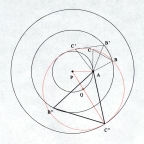Three Circles Problem
Problem: Given a point P in the plane, construct an equilateral triangle whose vertices are 1, 2, and 3 units, respectively, from P.
Solution: Draw concentric circles centered at P, of radius 1, 2, and 3. The task is to find an equilateral triangle with vertices on each of these circles. Let point A be the point on the inner circle directly to the right of P. For each point B on the middle circle, construct the equilateral triangle ABC by proceeding from A to B to C in counter-clockwise fashion. A solution is one of these triangles with point C on the outer circle.
All the points C trace out a fourth circle, because the transformation taking B into C is a rotation by +π/3 around point A, and such transformations take circles into circles. The transformation preserves the radius and maps centers also, so the radius of the new circle is also 2 and its center is obtained by rotating P around A by +π/3. This is point Q in the diagram, 60° south of east from P and 1 unit from it, on the inner circle.
This circle intersects the outer circle in one point C", and triangle AB"C" solves the problem, where B" is the point on the middle circle mapping to C".
The Law of Cosines produces the length AC" when applied to triangle PAC", since PA = 1, PC" = 3, and the angle between them is 60°:
AC"2 = PA2 + PC"2 - 2(PA)(PC")cos60°
= 1 + 9 - 2 × 1 × 3 × ½
= √7
Therefore the side of the equilateral triangle AC" = √7.
QED.
Note: Professor Dan Pedoe's book Geometry:A Comprehensive Course is the magic key for this type of problem, particularly Chapter II (Circles) and Chapter V (Mappings of the Euclidean Plane). Here are some problems in the same vein:
Problem: Given three distinct parallel straight lines in the plane, construct an equilateral triangle with vertex on each line.
Problem: Given three distances a, b, c, construct (using straightedge and compass and without analytic geometry) a square ABCD and a point P such that |PA| = a, |PB| = b, and |PC| = c (Mathematics Magazine, Problem 1418, April 1993).
